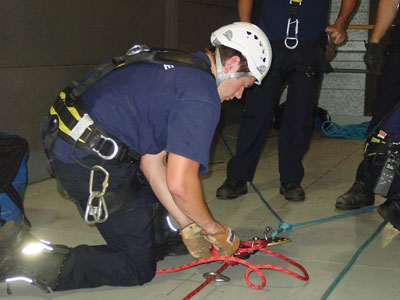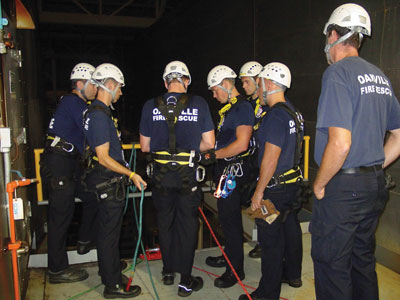
Features
Emergency & disaster management
Hot topics
The status of training
Has the fire service standardized training since 9-11? In my opinion, if we are honest with ourselves, the answer would be no – at least, not because of 9-11.
September 7, 2011
By Brad Patton
Has the fire service standardized training since 9-11? In my opinion, if we are honest with ourselves, the answer would be no – at least, not because of 9-11. However, there has been some movement in that direction, especially on some of the major health-and-safety issues affecting the Canadian fire service. Standardized training in the fire service is a difficult subject to tackle, as it is fundamentally driven by local needs and circumstances, including funding.
 |
|
| Although there’s lots of talk about standardized training, different municipalities have different needs. Photos by laura king
|
There are many facets to this subject. Numerous fire departments claim to be professional organizations – whether full-time, part-time or volunteer – and I’m sure that they are. Still, we do not have a recognized professional-standards body that reviews and approves all of our training. At a high level, we should all be practising the same fire-ground training regarding the incident command system and firefighter accountability, as well as selection and use of personal protective equipment. We should all know how to rescue our own (as in RIT training) and how to read smoke. We should all know and understand the dangers of lightweight construction and the proper way to fight a fire in a residence. All of these things – and many more strategies and tasks we do every day – are common in the fire service. However, what about auto extrication, first aid, uses of different water supplies, high-angle rescue, water rescue, grass and brush fires, CO alarms and grow ops? What are the standards for these disciplines?
There seem to be a few driving forces in standardizing training, and none is coming from the fire service or as a result of the tragic events of 9-11. For the most part, in Ontario, the Ministry of Labour, legal liabilities and cost efficiency are the catalysts for standardized training. The first two items are connected: if you or your fire department have a firefighter injury – or worse, a line-of-duty death – you will receive a visit from someone from the Ministry of Labour and/or a civil liability lawyer wanting to know how you train, what records you keep, who the training officer is and what his or her qualifications are, among other things. The training you do will be measured against recognized standards to evaluate its adequacy; those standards may come from the Ministry of Labour itself or from other provincial and/or federal regulations.
You may be measured by industry best practices if, for example, the department down the road has a policy that states that first-in crews must do a perimeter check to look for health-and-safety hazards before approaching the vehicle upon arrival at a motor vehicle accident, and you don’t have this in your policy. If a firefighter gets hurt at the scene, you or your department could be liable. This example alone is a very good reason for the implementation of standardized training, and there are many more examples of these kinds of comparisons being applied to fire departments.
 |
|
| A lack of provincial and federal financing for fire deparments plays a role in the standards for training. Photos by laura king
|
It is true that there is protection in numbers, so why isn’t there one complete set of standard operating guidelines, a policy and a training guide for auto extrication? Why can’t we just go to a zone or provincial library and pick out the standard lesson plans for auto extrication, water rescue, CO alarms and everything else to which we all respond, and know that these are proven lesson plans and teaching plans that meet expectations?
Is standardized training really more cost efficient? In my sometimes-humble opinion, it sure is! It doesn’t take a rocket scientist to figure out that if rural areas can come together and hire one or two training officers to work with several departments, the quality of the training will increase and improve for all departments involved. This kind of co-operation will increase firefighter safety and decrease liability. Once again, if several departments share the cost of hiring and retaining staff, it will be more financially manageable for all involved.
So, let’s look back to the start of this column. What sets the fire service apart from our police and EMS partners? Well, most of us do not get any provincial or federal funding. The wording in our governing legislation may not be as clear as that of police or EMS, but we do have some tools. First, if your department is not meeting health-and-safety regulations, it is imperative that this is fixed, or you must stop providing that service. Regardless of the issue – whether it is staffing, equipment or training – it has to be fixed, even if it means going to your council. In the past, I have called and had meetings with Ministry of Labour staff and health-and-safety professionals and found them great to work with. They can supply a lot of information that you can use or provide to your council. I have even had Ministry of Labour staff assist in the presentations to council; they would rather be proactive and help you prevent an accident than charge you after an accident.
In order for the Canadian fire service to move ahead, it has to start talking with one voice. We can no longer afford to be a fractured organization. We need to work together on our common goals to create a superior fire service; that might mean five or six fire departments amalgamating with one chief, one chief training officer, three deputies and two fire prevention officers. If that is a more effective and efficient way to deliver services, then we need to put on our big-boy pants and get ’er done! And, we must become much more active in our associations. Associations involving large numbers of fire-service personnel can accomplish a lot, but they need an engaged membership; and they need to listen to the needs of the members in addition to providing solutions to problems. Associations need an energetic executive and that’s where we can help: I encourage everyone who can to join and be active in our associations. There are associations for everyone: fire chiefs, senior officers, firefighters, training officers, prevention officers, mutual aid members and others, at local, provincial and federal levels. Just get out there and start working together. You can find a great list of associations on Firehall.com at www.firehall.com/listlink.php?list=association. Our associations are working with provincial and federal governments to make a better fire-and-rescue service that will safely meet the needs of our communities.
Has the fire service changed since 9-11? Yes, it has. Do I think any of the changes have anything to do with 9-11? No, I don’t. We just know the fire service needs to change and are willing to move forward to make those changes happen.
Brad Patton is fire chief for the Centre Wellington Volunteer Fire Rescue Department in Ontario. Centre Wellington, with a population of 28,000, covers 410 square kilometres and has stations in Fergus and Elora. Contact him at BPatton@centrewellington.com
Print this page